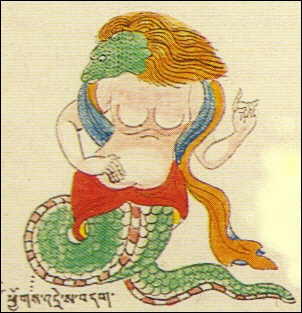Indian scripts in Tibet

As a matter of fact there are only few people in the world who can read or write Lantsha- and Vartu-script and even fewer who have experience and expert knowledge of the Bon Smar-script and the different kinds of Zhang-zhung scripts.
This web-site is an attempt at a short and well-founded introduction into the exciting and thrilling world of the ancient and divine scripts used by Buddhist monks in India and Tibet in the 11th century .
The charts of fonts displayed as a gallery on the next page explain the nuances:
Common belief is that most Buddhist Sanskrit manuscripts of the 11th century are written in Ranjana. But that is not the case. The importance of the Nepalese Ranjana is well known, but for Buddhist tradition the diversification and development from Ranjana into the Lantsha and Vartu script is more important. Although Ranjana and Lantsha are often described as similar there is a large amount of variation at the detailed script level.
Both scripts, Lantsha and Vartu, became the fundamental vehicle of Buddhist textual tradition. Lantsha script not only acts as a binding force for the Buddhist community, but what is more important these signs are a distinct mark of identification in mantras and Buddhist texts. For example the Buddhist Mahayana text in Lantsha was transferred from India to Tibetan monasteries.
In some monasteries and other traditional places translators developed their own scripts out of the Brahmi scripts similar to Lantsha and Vartu and used these scripts to transcribe Tibetan written thoughts and commentaries to expand the literature at those holy places. Calligraphy of all the developed scripts became a meditating point for the Buddhist monks and spiritual education in Tibetan monasteries. Up to now these scripts have considerable influence on the aesthetic and intellectual achievement of Buddhist society and culture.
In the Nyingma tradition, the oldest Buddhist school, exist some other scripts named "terma scripts" or "dakini scripts". You arre invieted to make a short virtual excursion through this wide range of exciting calligraphy of dakini scripts. Read more and click a new special web-site.
http://www.dakiniscripts.at
The activity and intention of this website exists in order to visualize these symboli scripts and to open up these treasuries of zhe artistic gifts to the entire public.
Years ago the Quinghai National Press published some pages i n an old Tibetan block styled script. Look at a new web-site.
http://www.tibetan-blockstyle.at

programm-highlights
|
|
||||||||||||||||||||||||||||||||
other interresting sites
|
|
e-mail: georg.fischer@chello.at
(C) 2004 - All rights reserved